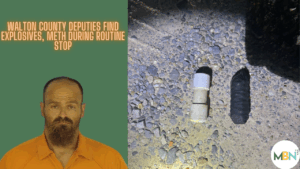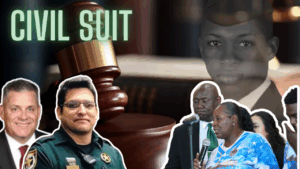
Almost 80 years ago – the members of the 2nd Fighter Squadron, the American Beagles, tasted victory in Europe against the Nazis and their allies. The unit fought in their P-40 Warhawks, P-39s, P-51s, and even a couple of British Supermarine Spitfires across the European continent to defeat Nazi Fascists.
To celebrate their victory, pilots in the squadron bought a pricey Royal Salute Scotch Whiskey aged 21 years. If you were curious, a bottle today would run you between $250 and $450. The bottle was only to be opened by the last man alive from the unit. Seventy-seven years later, the bottle found its final unopened home with the squadron’s heirs.
At a small ceremony, between the screams of jets taking off and landing – a small group of people gathered on a balmy northwest Florida morning to honor those men – and present the bottle to the commander of the 325th Fighter Wing, of which the 2nd Fighter Squadron is a part.


Major Chris Mills – with the 2nd Fighter Training Squadron told Mel’s story. The Colonel was shot down over German territory, bailed out, and was nearly killed by residents of the area. Taken into custody – he survived for two months in a prisoner of war camp before General George Patton’s unit liberated the camp.
The day was February 24th, 1945. The Germans had just been turned back by stiff American resistance in the cold forests of Luxembourg and Belgium at the Battle of the Bulge. The Nazis held their homeland and part of the Netherlands – the Americans and their allies had them on the run.
That’s when Bryant was shot down and made a prisoner of war for 66 days.
“Colonel Bryant was escorting B-17s to targets in Germany, which included a planned dropdown following the escort duty to attack targets of opportunity. Colonel Bryant and his wingmen had dropped down to low altitude and were following a railroad track to a village named Horb. They flew up on a train that stopped. These trains were usually armed with guns, so Colonel Bryant and his wingmen decided to turn around and try to shoot it. When the engine blew up, Colonel Bryant thought, ‘it was quite a pretty sight, and I got a smile on my face.’ However, the next thing he knew, his canopy turned black. He had been shot by a gun on the train, hitting his oil system, which splattered on his canopy. They attempted to get as close to friendly territory as possible before his engine stopped, and he had to get out of the airplane. He unbuckled from the [plane] and went to jump out but was pushed back into the cockpit by the slipstream. With the plane no longer producing thrust and the dangerously low altitude, he thought, ‘I’ve got to get this done, and made an effort to throw himself out of the plane. However, he didn’t go very far from the aircraft, and his right side hit the horizontal stabilizer on the tail, spinning him. Fortunately, he had not been hurt badly enough that he was able to grab his ripcord and open his chute. Soon after, he hit the trees. Colonel Bryant attempted to walk but found out that he had been paralyzed from the hit. Shortly after, he was picked up by two old woodsmen that seemed relatively friendly. They picked him up off a path out of the woods and into town. People began to come out fo the town hollering and screaming and carrying on. He was then dropped by the woodsmen and was then assaulted by the townspeople. The mayor of the town held a pistol to his head and Colonel Bryant had nothing to do but pray since he could no longer help himself. Luckily, a German soldier came into the town, got the townsfolk away and put Colonel Bryant into a truck. It was at that point that he was in custody of the German military. Perfect timing as well, otherwise the townsfolk probably would have killed him.” recounted Major Mills at the ceremony.
Mills continued, “Colonel Bryant ended up in the headquarters and was in desperate need of a doctor. He was moved into a prison camp outside of Frankfurt where he was interrogated. He was kept in solitary confinement with a little door through which they could put food. He would have to beat on the door if he had to use the bathroom and they would have to escort him there and back. The Germans would say, ‘you cooperate with us and we will send you out of the prison camp where they have softball and movies and they will treat you good. Just tell us what we want, and we will ship you someplace nice.’”
“They would ask him questions about his squadron and his airplane, but he didn’t share any information that they requested. Colonel Bryant was there for a week being interrogated, after which, he was transferred to a Red Cross transit camp. After this, he was given a couple small pieces of clothing and one toothbrush that had to be shared between seven men. He was then moved to a camp in Nuremberg and from there a 17-day march started on the 4th of April to a camp called Moosberg,” said Mills.
It wasn’t until the 29th of April, 1945 that Colonel Bryant was freed.

The mayor of the town held a pistol to his head and Colonel Bryant had nothing to do but pray since he could no longer help himself.
Colonel Mel Bryant's Account Tweet
“He was an awesome guy, he loved his job and he put it first. His last assignment was base commander at Hurlburt and Ilearned a lot from him I didn’t know, “Bryant said, “I miss him more than I could even tell you.”
Receiving the bottle – Colonel George Watkins, 325th Fighter Wing Commander. Watkins told the crowd that when the 325th Fighter Wing’s base at Tyndall is rebuilt, the bottle will have a special place in the building – along with other memorabilia.
“To be up here today to be a part of this ceremony, to be honoring the legacy of our heroes today. I think it’s super important to bring that history, to remember it, to bring it and to continue to teach our fighter pilots and our young airmen across the Air Force about our history and about where we come from,” said Watkins.
The bottle will be unique – and a needed piece of history for the unit, which saw their base wiped out by Hurricane Michael in 2018.
Lieutenant Colonel Brent Blandino, the current 2nd Fighter Training Squadron commander, watched the ceremony with some of the pilots in his unit. Blandino noted that there is something special about the pilots from the Greatest Generation.
“The thing that catches me about those stories is in those personal accounts where you get to hear the words of people who experienced it – you don’t hear a tone of doubt or concern, you hear an uplifting and upbeat tone in every single one where they are just going through their life, they area just doing their job and maybe they don’t even realize the gravity or the situation of how unbelievable the situation is that they are experiencing at the time,” said Blandino.
Colonel Bryant was not the original holder of the bottle of scotch, which was given initially to the youngest man in the squadron. But, in 2015 – when the previous youngest pilot died – Bryant became responsible for the bottle.
As a remembrance of the men who served in the Second World War when the squadron was organized – each of the T-38 aircraft the squadron uses will have the name of a pilot from that era added to the plane.

To be up here today to be a part of this ceremony, to be honoring the legacy of our heroes today. I think it’s super important to bring that history, to remember it, to bring it and to continue to teach our fighter pilots and our young airmen across the Air Force about our history and about where we come from.
Colonel George Watkins Tweet

The original name of the 2nd Fighter Training Squadron, was the 2nd Pursuit Squadron which was activated on January 15th, 1941 – before the American entry into the Second World War. On the 15th of May, 1942, the designation ‘pursuit’ was replaced by ‘fighter’ in the name of the unit.
247 officers and enlisted men composed the fighter squadron at its inception. It served in WWII with the 52nd Fighter Group and flew the P-40 Warhawk, the P-39 Air Cobra. The fighter squadron also flew the Supermarine Spitfire and the P-51 Mustang in the European and Mediterranean theaters of war.
The American Beagles ‘killed’ 184 and one third aircraft killed in the war. A total of 181 German and 3 Italian aircraft were destroyed by the Beagles. 37 officers and enlisted personnel were killed in action or in the line of duty during the war. 21 officers ended up in prisoner of war camps.
A total of 11 pilots earned the ‘Ace’ designation for killing five or more aircraft.
The 2nd Fighter Squadron was deactivated immediately after the war, but the Air Force has reincarnated it several times to suit the military’s needs. In the eight decades since World War Two, the unit has been a fighter intercept squadron, fighter weapons squadron, tactical fighter training squadron and now a fighter training squadron.




